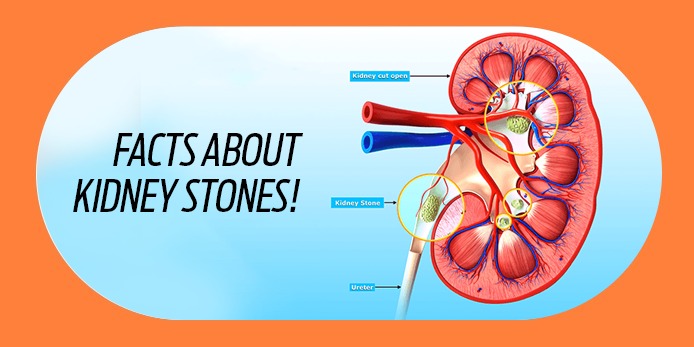Kidneys are the bean-shaped organs present above the bladder. From producing urine to maintaining electrolyte balance in the body, they play a very important role in our body. The word kidney is probably a compound of the Old English cwið, “womb,” and ey, “egg,” describing the organ’s shape.
Kidney stones are hard deposits that develop in the kidneys from substances in the urine. Most kidney stones pass out of the body without help from a doctor. But sometimes a stone will not go away. It may get stuck in the urinary tract, block the flow of urine and cause great pain.
Since it is one of the most common conditions in the world. There are many facts about kidney stones. Here are we listing a few of them.
- More than one type of stone exists
There are four types of kidney stones-
- Calcium Stones- the most common type.
- Struvite Stones- Another common type of stone, formed due to repeated urinary tract infections.
- Uric Acid Stones- Forms when urine is too acidic. This type of stone run in families.
- Cystine Stones- Rarest, form due to a hereditary disorder, cystinuria.
Calcium and cystine stones are hard while Struvite stones tend to be softer and larger, they can even take the entire area where urine gets collected in the kidneys. Uric Acid and Calcium stones seem similar in appearance but they are tricky to catch as they can’t be seen on an X-Ray
- There are many colours of kidney stones-
They come in almost all colours. Most of the time, the colour of kidney stones is yellowish or yellowish-white, but some can have darker interior portions too. The surface of kidney stones may either be smooth or jagged.
- Kidney stones are of different sizes-
The larger the stone, the more noticeable are its symptoms. Even the pain level depends on the shape and size of the stone. The smaller ones can pass without you noticing, but the bigger ones can be hurtful. That’s why it’s said that sometimes, passing a kidney stone can be as painful as childbirth!
They can be as small as a size of pea and as large as size of golf ball! The larget kidney stone ever recorded, according to Guinness World Records, was 5 inches in diameter.
- Certain foods can cause stones — but not calcium
Ironically, although calcium can be the main component of kidney stone but having calcium doesn’t lead to the stone formation, unless you are eating too much of it.
So what food you shouldn’t eat?
Vitamin C supplements and high salt or protein intake can lead to the stone formation or can make your stone grow in size.
Salt keeps calcium from being absorbed by the body.
“In addition, foods rich in oxalates, such as nuts, chocolate, spinach, and tea, may cause increased stone formation,” he adds.
- Water- The key player!
Not drinking enough water plays a 50% role in developing kidney stones. Therefore, it is necessary to make 2.5 litres of urine per day. Clear urine or pale-yellow urine is a sign of good health.
Also, salt may lead to stones, but good old H2O can help prevent them.
6. Kidney stones are more common in summer and in hotter climates.
There’s a reason summer is called kidney stone season. “Hot weather leads to dehydration, which causes more kidney stones in warmer climates.”
Therefore, drink your water, even if it’s hot! Also, whenever you are exercising or doing “hot yoga”, make sure that you are hydrated as well.
7. More than 1 in 10 people will have a kidney stone at some point in their lives.
Unfortunately, kidney stones are common. They happen more in men than women. A study in America estimated that 12% of Americans will develop a kidney stone in their lifetime.
8. Once you have one stone, you’re more likely to have another.
One stone may not be all you ever have in your lifetime. If you had a kidney stone, there’s a 50% chance that you’ll develop another in the next five years. So, once you experience a stone, it’s especially important to follow your doctor’s recommendations.
9. Kidney stones are linked to other conditions.
There are various risk factors associated with kidney stones. Conditions like obesity, diabetes, recurrent urinary tract infections and other metabolic disturbances can lead to kidney stones. Hence, stones are related to other conditions too.
10. Kidney stones can be treated with shock waves
Extracorporeal shock wave lithotripsy uses high-energy sound waves as a non-invasive way to break certain kidney stones so they’re easier to pass. You still need to be given anaesthesia before this procedure.





